How to turn dandelion into a staple good-tasting member of your diet | Cómo transformar el diente de león en un miembro estable y de buen sabor en tu dieta

If where you live it's spring, you're likely to find a lot of dandelions growing like crazy, as this is a plant that grows pretty much world-wide. If not, you can find this plant year round, only that mid spring is when you'll find it in it's prime in what leaves and flowers refer.
Si donde vives es primavera, es probable que encuentres un montón de dientes de león creciendo como locos, ya que se trata de una planta que crece prácticamente en todo el mundo. En caso de que estés en otra estación no hay problema, puedes encontrar esta planta el año entero, solo que en primavera es cuando tiene hojas y flores en mayor abundancia.

With these huge leaves it's natural to think it would be great if the plant tasted good and could be a source of infinite free food (at least for those of us who aren't in the food industry, those guys hate the idea of infinite free food).
Unfortunately, the taste can be quite bitter, which leads us to pass by, even if there is a lot of evidence on their amazing nutritional properties.
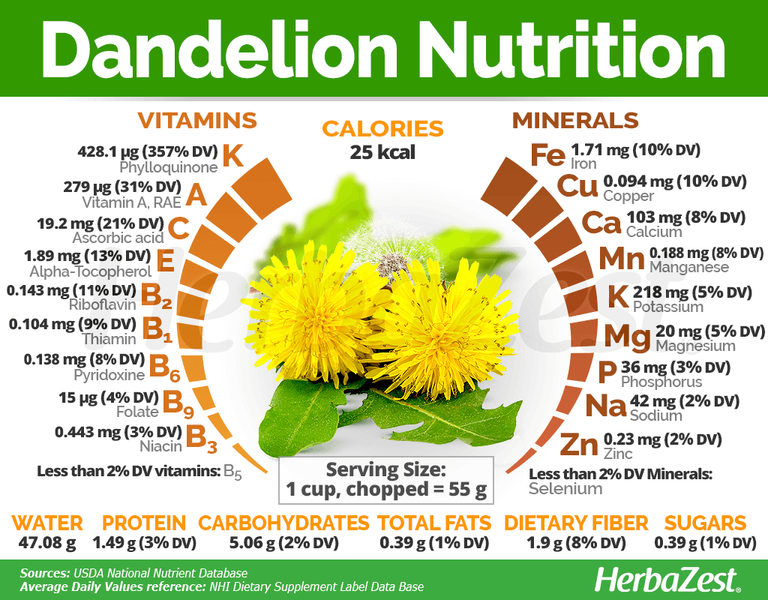
Con esas enormes hojas es natural pensar que sería genial que la planta tuviese buen sabor y pudiera ser una fuente de comida gratis infinita (al menos para los que no estamos en la industria alimentaria, esos locos odian la idea de comida gratis infinita).
Desafortunadamente, su sabor puede ser bastante amargo, lo que nos lleva a pasar de largo, aunque haya muchas pruebas sobre sus asombrosas propiedades nutricionales.
While I know of many who add the plant into salads or just eat a leaf here and there to get the nutritional benefits, I've figured out a way to turn it into a staple food, so here's how I process it so that you can do it too, if you wish.
Aunque sé de muchos que añaden la planta a las ensaladas o simplemente comen una hoja aquí y allá para obtener los beneficios nutricionales, he estado desarrollando una forma para que pueda ser un alimento estable en la cocina, así que aquí te cuento cómo la proceso para que tú también puedas hacerlo, si lo deseas.

Obviously the first step is to forage as much as you can, with no worry in your heart because this plant grows back with insane ease. As you might know, farmers actually fight against it with all kind of methods, from chemicals to uprooting it manually, and till this day they haven't been able to beat it. Gosh, I'm proud of this plant, if I was in feudal times I would make it the symbol of my house.
I go for big leaves and flowers with stalk and everything as this way you amass a nice amount in very little time. If you go for smaller rosettes they might have less bitterness but it will take longer to harvest, and it doesn't matter because we'll be removing the bitter ;)
Obviamente, el primer paso es recolectar todo lo que se pueda, sin ninguna preocupación en el corazón, porque esta planta vuelve a crecer con una facilidad demencial. Como quizá sepas, los agricultores luchan contra ella con todo tipo de métodos, desde productos químicos hasta arrancarla manualmente, y hasta hoy no han podido vencerla. Dios, estoy orgulloso de esta planta, si estuviera en la época feudal la convertiría en el símbolo de mi casa.
Yo me decanto por hojas grandes y flores con tallo ya que de esta forma acumulas una buena cantidad en muy poco tiempo. Si te decantas por rosetas mas pequeñas puede que tengan les amargor pero tardaras mas en cosechar, y no importa porque estaremos quitando lo amargo ;)

Oncce foraged, chop them and put them in a pot leaving enough space for abundant water. The more water it has, the easier the bitterness is removed so you'll have to play around until you find the right balance for the biggest pot you might have. I like to chop them fast and big for this process and go for the finer cuts after cooking them, but it's up to you how you prefer to do it.
Una vez recolectadas, hay que picarlas y ponerlas en una olla dejando espacio suficiente para abundante agua. Cuanta más agua tenga, más fácilmente se eliminará el amargor, por lo que tendrás que ir jugando hasta encontrar el equilibrio adecuado para la olla más grande que tengas. A mi me gusta picarlas en trozos grandes primero y luego hacer cortes mas finos tras su cocción.

Put them to boil for 10-20 minutes
Ponlas a hervir de 10 a 20 minutos

Their color will get darker and they will be ready.
Su color se oscurecerá y estará listo.
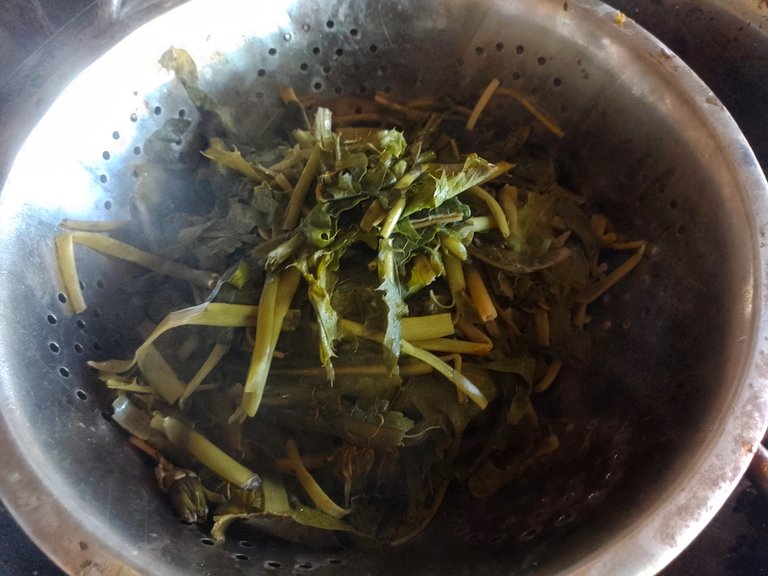
Remove the water, you can wait for it to cool and pour it in the garden.
Quita el agua, puedes esperar a que enfríe y regarla en la huerta.
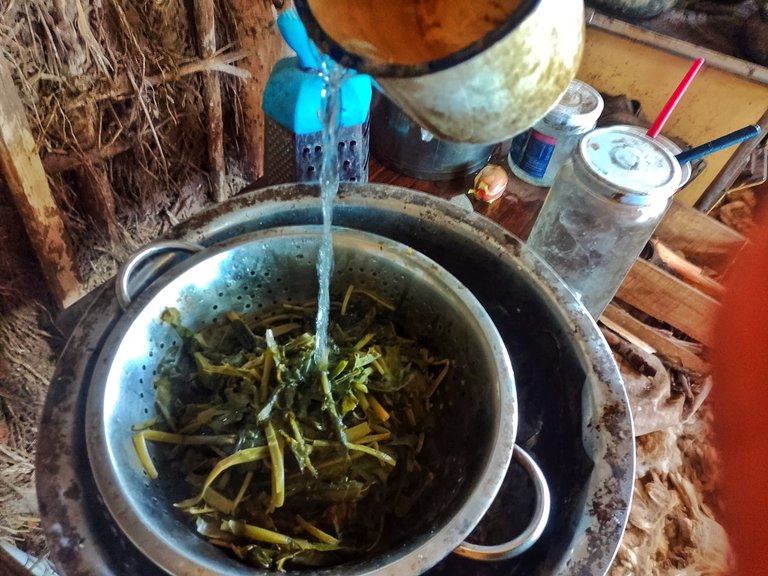
Rinse them to cool the off and also begin removing some of the bitter taste.
Enjuaga para enfriarlas y empezar a eliminar parte del sabor amargo.

⚠️ This step is very important ⚠️
You have to squeeze them very thoroughly. I had to take the picture with one hand but you must use both for the squeeze. The better you squeeze, the more bitterness you will remove. Start slowly to make sure their not hot inside and you don't burn yourself.
⚠️ Este paso es muy importante ⚠️
Hay que exprimirlos muy bien. Yo tuve que hacer la foto con una mano pero debes usar las dos para exprimirlos. cuanto mejor los exprimas, más amargor les quitarás. e
Empieza despacio para asegurarte de que no están calientes por dentro y de que no te vayas a quemar.
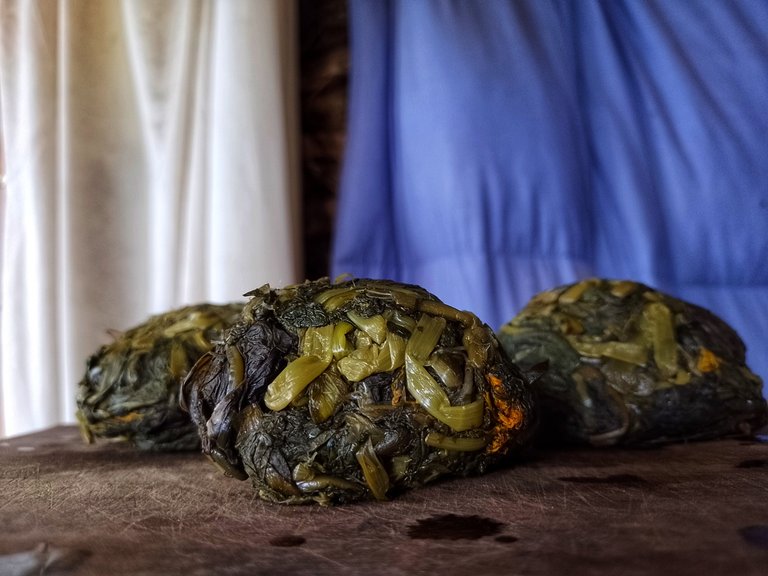
I like to give them this ovoid shape after the squeeze
Me gusta darles esta forma ovoide después de apretarlos
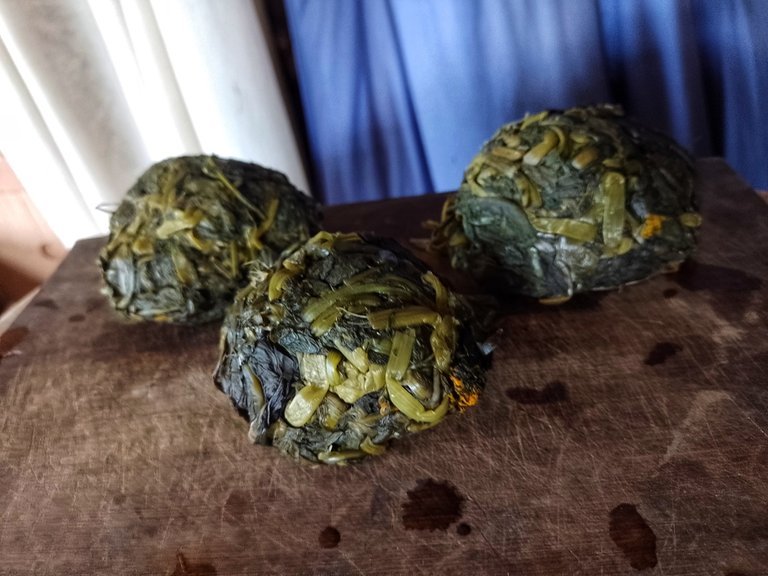
From here you could already use it in your next meal. You can stir fry it or marinate it in different things to flavour it up. However, the fibers sometimes become a bit tough so I take an extra step that is chopping these up a bit finer.
A partir de aquí ya puedes utilizarlo en tu próxima comida. puedes saltearlo o marinarlo en diferentes cosas para darle sabor. Sin embargo, las fibras a veces se vuelven un poco duras, por lo que doy un paso extra que es picarlas mas finas.

A serrated knife is best for the job.
Un cuchillo de sierra es mejor para el trabajo.

This seems to me the optimal condition to use in a meal. Of course there is always room for improvement so feel free to give suggestions in the comments.
Esto me parece óptimo para usar en una comida. Por su puesto que siempre hay espacio para mejorar así que siéntete libre de hacer sugerencias en los comentarios.
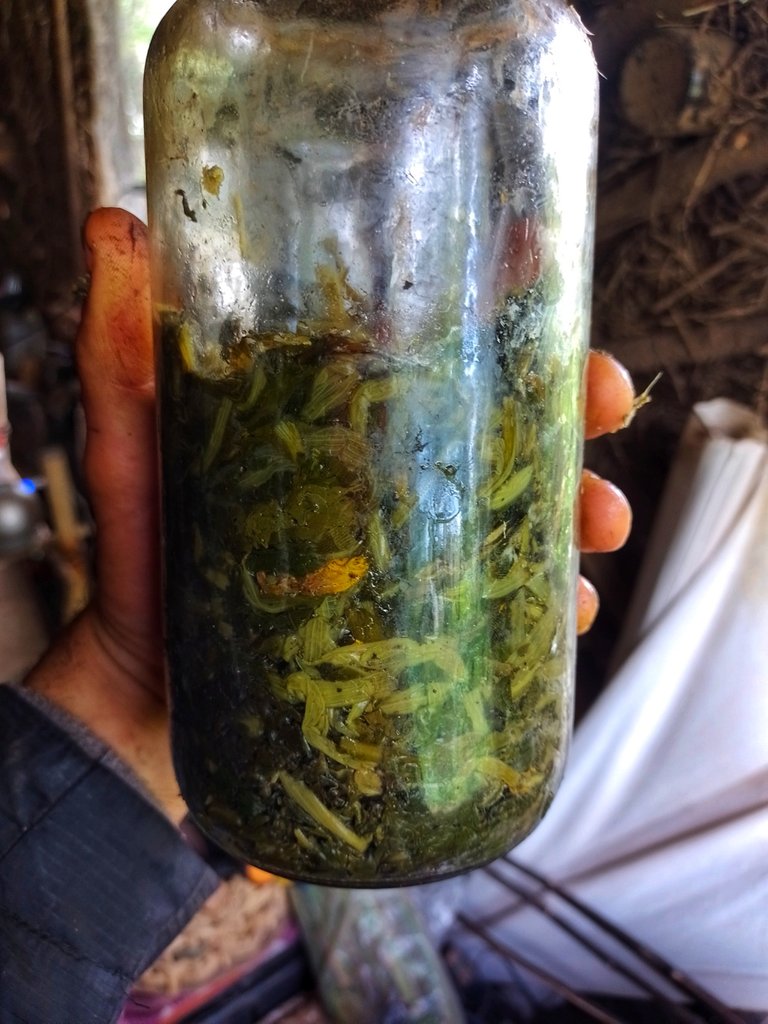
In this case I'm going to store since I already cooked today. I pushed this down tight into the jar so it was reduced to what seems a small amount, but actually it's quite a bit of food. Once I fill the jar I will probably pickle them and save them for a hungry day when I don't feel like foraging hehe. After pickled you can still use them as any other veggie on food so it's very versatile.
There might be a little of bitterness left but it's so mild that it actually adds to whatever you're cooking, without being something that takes away palatability.
En este caso voy a guardar ya que hoy ya he cocinado. Empujé esto hacia abajo apretando con fuerza para reducir el aire en el frasco por lo que se redujo a lo que parece una pequeña cantidad, pero en realidad es bastante comida. Una vez que llene el frasco probablemente voy a encurtir y guardarlos para un día de hambre cuando no me apetezca salir a recolectar. Una vez en escabeche todavía se puede utilizar como cualquier otra verdura en los alimentos por lo que es muy versátil.
Puede que un un mínimo de amargo pero es tan leve que en verdad agrega sabor a la comida sin ser algo que reduzca su valor culinario.
I hope this is useful to you, happy foraging 🍀
Espero que esto te haya servido, felices recolecciones 🍀
You've been curated by @plantpoweronhive! Delegations welcome!
Thanks 🙏
In fact, so many veggie with bitter taste but yeah veggie lovers still want eat them for sure.
Here have no dandelion 😊
Yeah, only dandelion can be so bitter it can ruin a meal if not processed so this way it's good to use in any dish :) what is the most common "weed" in Indonesia?